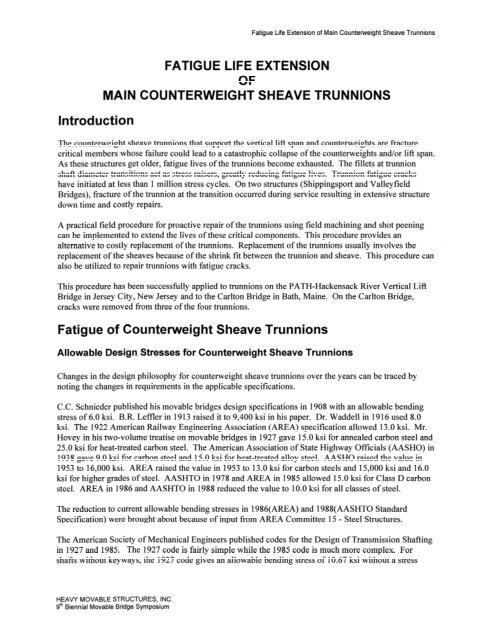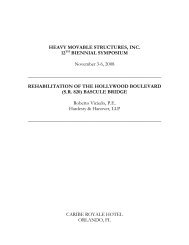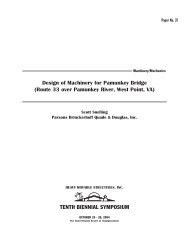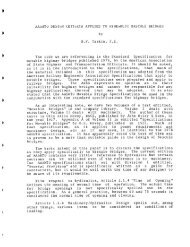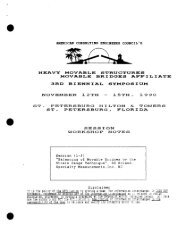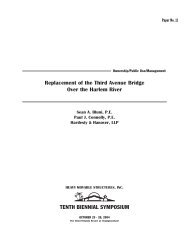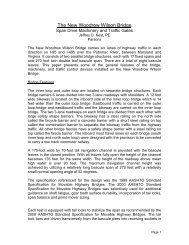Fatigue of Counterweight Sheave Trunnions - Heavy Movable ...
Fatigue of Counterweight Sheave Trunnions - Heavy Movable ...
Fatigue of Counterweight Sheave Trunnions - Heavy Movable ...
Create successful ePaper yourself
Turn your PDF publications into a flip-book with our unique Google optimized e-Paper software.
Introduction<br />
<strong>Fatigue</strong> Life Extension <strong>of</strong> Main <strong>Counterweight</strong> <strong>Sheave</strong> <strong>Trunnions</strong><br />
FATIGUE LIFE EXTENSION<br />
OF<br />
MAIN COUNTERWEIGHT SHEAVE TRUNNIONS<br />
The counterweight sheave trunnions that support the vertical lift span and counterweights are fracture<br />
critical members whose failure could lead to a catastrophic collapse <strong>of</strong> the counterweights and/or lift span.<br />
As these structures get older, fatigue lives <strong>of</strong> the trunnions become exhausted. The fillets at trunnion<br />
shaft diameter transitions act as stress raisers, greatly reducing fatigue lives. Trunnion fatigue cracks<br />
have initiated at less than 1 million stress cycles. On two structures (Shippingsport and Valleyfield<br />
Bridges), fracture <strong>of</strong> the trunnion at the transition occurred during service resulting in extensive structure<br />
down time and costly repairs.<br />
A practical field procedure for proactive repair <strong>of</strong> the trunnions using field machining and shot peening<br />
can be implemented to extend the lives <strong>of</strong> these critical components. This procedure provides an<br />
alternative to costly replacement <strong>of</strong> the trunnions. Replacement <strong>of</strong> the trunnions usually involves the<br />
replacement <strong>of</strong> the sheaves because <strong>of</strong> the shrink fit between the trunnion and sheave. This procedure can<br />
also be utilized to repair trunnions with fatigue cracks.<br />
This procedure has been successhlly applied to trunnions on the PATH-Hackensack River Vertical Lift<br />
Bridge in Jersey City, New Jersey and to the Carlton Bridge in Bath, Maine. On the Carlton Bridge,<br />
cracks were removed from three <strong>of</strong> the four trunnions.<br />
<strong>Fatigue</strong> <strong>of</strong> <strong>Counterweight</strong> <strong>Sheave</strong> <strong>Trunnions</strong><br />
Allowable Design Stresses for <strong>Counterweight</strong> <strong>Sheave</strong> <strong>Trunnions</strong><br />
Changes in the design philosophy for counterweight sheave trunnions over the years can be traced by<br />
noting the changes in requirements in the applicable specifications.<br />
C.C. Schnieder published his movable bridges design specifications in 1908 with an allowable bending<br />
stress <strong>of</strong> 6.0 ksi. B.R. LeMer in 19 13 raised it to 9,400 ksi in his paper. Dr. Waddell in 19 16 used 8.0<br />
ksi. The 1922 American Railway Engineering Association (AREA) specification allowed 13.0 ksi. Mr.<br />
Hovcy in his two-volume treatise on movable bridges in 1927 gave 15.0 ksi for annealed carbon steel and<br />
25.0 ksi for heat-treated carbon steel. The American Association <strong>of</strong> State Highway Officials (AASHO) in<br />
1938 gave 9.0 ksi for carbon steel and 15.0 ksi for heat-treated alloy steel. AASHO raised the value in<br />
1953 to 16,000 ksi. AREA raised the value in 1953 to 13.0 ksi for carbon steels and 15,000 ksi and 16.0<br />
ksi for higher grades <strong>of</strong> steel. AASHTO in 1978 and AREA in 1985 allowed 15.0 ksi for Class D carbon<br />
steel. AREA in 1986 and AASHTO in 1988 reduced the value to 10.0 ksi for all classes <strong>of</strong> steel.<br />
The reduction to current allowable bending stresses in 1986(AREA) and 1988(AASHTO Standard<br />
Specification) were brought about because <strong>of</strong> input from AREA Committee 15 - Steel Structures.<br />
The American Society <strong>of</strong> Mechanical Engineers published codes for the Design <strong>of</strong> il'ransmission Shafting<br />
in 1927 and 1985. The 1927 code is fairly simple while the 1985 code is much more complex. For<br />
shafts without keyways, the 1927 code gives an allowable bending stress <strong>of</strong> 10.67 ksi without a stress<br />
HEAVY MOVABLE STRUCTURES, INC.<br />
gth Biennial <strong>Movable</strong> Bridge Symposium


